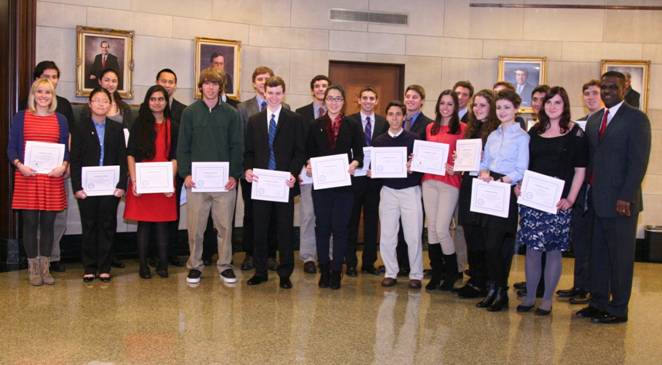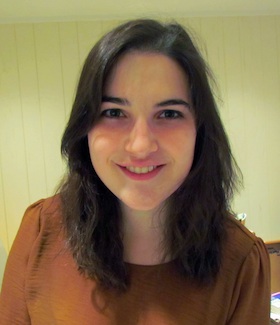Three SHS Students Named Intel Semi-Finalists
- Tuesday, 19 February 2013 12:50
- Last Updated: Tuesday, 19 February 2013 13:04
- Published: Tuesday, 19 February 2013 12:50
- Hits: 6033
 Scarsdale High School's science research program had a banner year– for the first time three SHS seniors were named Intel semi-finalists for their science research projects. Under Beth Schoenbrun, the Director of Science Research at the high school, Kathryn Evans, Madeleine Minke and Jamie Tanzer, who represent 75% of the school's eligible students, were awarded this prestigious prize.
Scarsdale High School's science research program had a banner year– for the first time three SHS seniors were named Intel semi-finalists for their science research projects. Under Beth Schoenbrun, the Director of Science Research at the high school, Kathryn Evans, Madeleine Minke and Jamie Tanzer, who represent 75% of the school's eligible students, were awarded this prestigious prize.
To what does Ms. Schoenbrun attribute her student's success? She says, "This was due to their own hard work, the complete support of the science research program by the district at every level, the strong efforts of Mrs. Laura Estersohn to help them analyze and understand their statistics, and Ms. Nicole Pisano's and my reading and re-reading their final papers." She also wished to add, "While we are very proud of our students, the goal is not to win science competitions, but to do original and hopefully publishable research. Any additional awards are icing on the cake."
The Scarsdale semi-finalists, along with other award winners from around the county were honored by the Westchester County Legislature on Monday February 11. In his remarks, Chairman of the Board of County Legislators Ken Jenkins said, ""Year after year, Westchester high school students prove themselves as being among the nation's best—in the classroom, in athletics and in their communities. Tonight, we honor this remarkable group of Intel Science Talent Search competition finalists and semi-finalists and congratulate them on their academic commitment, unceasing efforts and cutting-edge intelligence. It is also important that we recognize that these students received a lot of support from parents, other family members and guardians in their quest for excellence. But there is one undeniable reason why Westchester can point to so many top science, tech, engineering and math students: the quality of our schools and the educators who are dedicated to ensuring a meaningful future for our children."
Here's information about the research projects submitted by Scarsdale's semi-finalists:
Kathryn Evans
Endogenous Retroviruses: I have spent the last two summers in the Rockefeller University lab of Dr. Robert Gifford studying fascinating genetic elements known  as "endogenous retroviruses." Retroviruses usually conjure up the image of spiky little particles of HIV; however, endogenous retroviruses are a fundamentally different sort of virus. Endogenous retroviruses, or ERVs, are genetic elements formed when retroviral genomes become permanent fixtures within the chromosomes of their hosts. ERVs have not been fully explored in the public genome data, which led to my assignment: characterize ERV diversity in Afrotheria, a diverse superorder comprising one third of the orders of placental mammals.
as "endogenous retroviruses." Retroviruses usually conjure up the image of spiky little particles of HIV; however, endogenous retroviruses are a fundamentally different sort of virus. Endogenous retroviruses, or ERVs, are genetic elements formed when retroviral genomes become permanent fixtures within the chromosomes of their hosts. ERVs have not been fully explored in the public genome data, which led to my assignment: characterize ERV diversity in Afrotheria, a diverse superorder comprising one third of the orders of placental mammals.
I used computer-based genome screening to characterize ERVs in the four sequenced Afrotherian genomes: rock hyrax, African bush elephant, West Indian manatee, and lesser hedgehog tenrec. I identified a total of ~88,000 ERV insertions, which I helped organize into a relational database. I grouped these insertions into 25 evolutionarily distinct groups through comparison of ERV protein sequences to one another, and to previously characterized retroviruses. This study provided the first comprehensive overview of ERV diversity in Afrotheria, and revealed lots of interesting ERV insertions that can be further explored in future research. One insertion I found seemed to provide evidence for a cross-species transmission of a retrovirus between Malagasy tenrecs and the Malagasy grey mouse lemur. This finding was interesting because a similar cross-species even is how HIV recently entered the human population.
Madeleine Minke
 Integration of Auditory and Visual Information: During multisensory integration, the brain combines information from different senses to create one "stream" of information. This study looked at the integration of auditory and visual information depending on whether the visual information warned the subject what the auditory information would be. EEG results showed that the original response in the audiovisual cortex was suppressed and speeded up, which indicates that the audiovisual information affects the way the brain responds to auditory stimuli. As the asynchrony of the stimuli increased, the severity of the brain's response increased, thus supporting the previous belief of the interactions between the auditory and visual sensory systems. The ultimate goal of the research is to develop a therapy for people with multisensory integration disorders.
Integration of Auditory and Visual Information: During multisensory integration, the brain combines information from different senses to create one "stream" of information. This study looked at the integration of auditory and visual information depending on whether the visual information warned the subject what the auditory information would be. EEG results showed that the original response in the audiovisual cortex was suppressed and speeded up, which indicates that the audiovisual information affects the way the brain responds to auditory stimuli. As the asynchrony of the stimuli increased, the severity of the brain's response increased, thus supporting the previous belief of the interactions between the auditory and visual sensory systems. The ultimate goal of the research is to develop a therapy for people with multisensory integration disorders.
Jamie Tanzer
The Role of Microbial Proteases in the Elicitation of Allergy and the Formulation of the Enzyme Hypothesis: The Enzyme Hypothesis proposes that laundry detergents may be an etiological contributor to allergic disease. Allergenic microbial enzymes in laundry detergents (particularly proteases, which break down proteins) and other laundry detergent ingredients, left as residue on clothing, weaken protein components of the skin barrier (a vital part of the immune system) and contribute to the development of allergy through the skin. Infant skin may be particularly vulnerable to this process. In my experiments, skin samples from adult and young mice were exposed to proteases or laundry detergent at concentrations equivalent to the amount left as residue on clothing. Both caused skin damage, with greater damage to the skin of young mice. These results suggest that further research on laundry detergent and its role in the development of allergy is needed.
research on laundry detergent and its role in the development of allergy is needed.